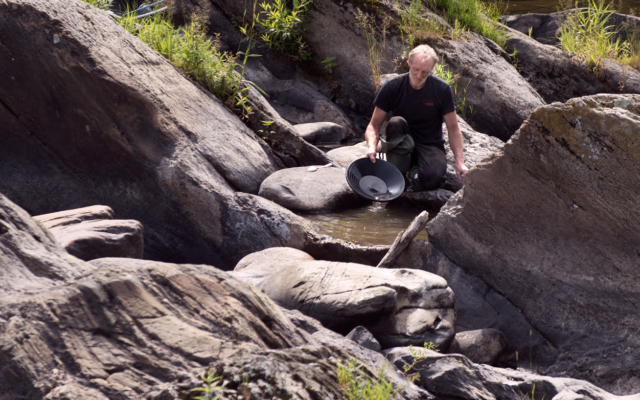
You can pan for gold and find rare rocks in Maine if you know where to look
By Emily Burnham, Bangor Daily News Staff
You’re likely not going to get rich panning for gold or digging for gems in Maine. But with some knowledge, determination and maybe some help from local mineral clubs, you might have a lot of fun doing it.
Rockhounding and gold prospecting are two activities that anyone with some basic equipment and know-how can partake in. Myles Felch, a curator and staff geologist at the Maine Mineral and Gem Museum in Bethel, said that while Maine is far from the gold-rich sites found in California or Alaska, there’s still enough to be found here that it can be a fun way to spend an afternoon.
“Maine just isn’t like those places out West. There’s never been a real lode discovered here. You’re not going to come across some big gold nugget,” Felch said. “That said, there are small amounts of it here, and people have had some success panning for it in some rivers.”
Coos Canyon in the town of Byron — about 20 minutes north of Rumford — is likely the most famous gold-panning site in Maine. The Coos Canyon Rock and Gift Shop, just across the street from the public canyon area, rents and sells pans, so people can try their hand at finding gold in the Swift River.
Other gold-panning sites in Maine include the Sandy River, Nile Brook and Kibby Stream, all in Franklin County; along the St. Croix River in Baileyville in Washington County; the South Branch of the Penobscot River in Somerset County; and three separate and aptly named Gold Brooks, in Somerset and Oxford counties. The Maine Geological Survey has a full list on its website.
If you’re willing to do some research, get necessary permissions and head out into the wilderness, there are likely other streams in western Maine that also have gold. There’s nothing stopping you from panning any river or stream — with a little patience, you never know what might show up.
There’s more than just gold in them thar hills, however. There are also a multitude of interesting rocks, minerals and crystals to be found in Maine.
Felch said that while you’re not going to find diamonds, sapphires or rubies in Maine, you can find stones like garnets, beryl, amethyst, agates and various other quartzes. Attractive minerals like lepidolite, Amazonite, muscovite mica and pyrite can also be found.
And while you’re unlikely to find tourmaline anywhere other than a jewelry shop or a museum, it’s not completely unheard of to stumble across a small piece of Maine’s state gem while poking through the rubble at old mines and quarries.
There are several popular publicly accessible rockhounding sites in Maine, including Mt. Apatite Park in Auburn, Deer Hill Mineral Collecting Area in Stow, Harvard Quarry in Greenwood and Poland Mining Camps in Poland.
Some of the most famous rocks and minerals to be found in Maine are on private property, and are off-limits without permission from the individuals, towns or state bodies that own them.
For instance, the deposits of the volcanic rock rhyolite on Mount Kineo on Moosehead Lake, which for millennia was harvested by Wabanaki people to use for arrowheads, isn’t free to take when you hike Kineo, which is a state park with a privately owned golf course next to it. Mount Mica in Paris is a privately owned mine where everything from rose quartz to tourmaline has been found and is only accessible to the public by joining a paid rock-finding field tip, held at 9 a.m. each Sunday from April through the fall by Dig Maine Gems.
And in Washington County, the famous Jasper Beach in Machiasport boasts a mile of millions of colorful stones, naturally tumbled by the surf — which you’re not allowed to take, despite the fact that many people ignore the rules and do it anyway.
Any hunter — for rocks, animals or anything else — will tell you that you can’t just wander onto private property without permission. That may in part be why no one has yet found the meteorite that may have crashed into a remote corner of Washington County in April 2023. The Maine Mineral and Gem Museum still has a $25,000 bounty up for grabs for anyone that can find a piece of that meteorite that weighs more than two pounds.
For rockhounds just getting started, Felch recommends connecting with a local mineral club. Maine has a number of such clubs, including the Maine Mineralogical and Geological Society in Portland, the Oxford County Mineral and Gem Association, the Kennebec Rocks and Mineral Club in Waterville, the Water-Oak Gem and Mineral Society in Waterville, the Penobscot Mineral and Lapidary Club in Milford and the Washington County Gem and Mineral Society.
“Clubs will help you learn much more about what’s out there, and they often organize trips onto private property because they have relationships with landowners,” Felch said.
There are also several useful websites to point you in the direction of places to look for interesting rocks and minerals. The Maine Geological Survey maintains a list of localities all over the state where various deposits have been found, and MinDat.org, an international open database for minerals, rocks, meteorites and the localities they come from, has hundreds of listings in Maine.
If you’re more interested in just looking at the pretty rocks rather than getting your hands dirty, however, the Maine Mineral and Gem Museum has thousands of specimens on display — from a nationally renowned collection of meteorites to enormous slabs of vividly-colored tourmaline, mined right here in Maine.